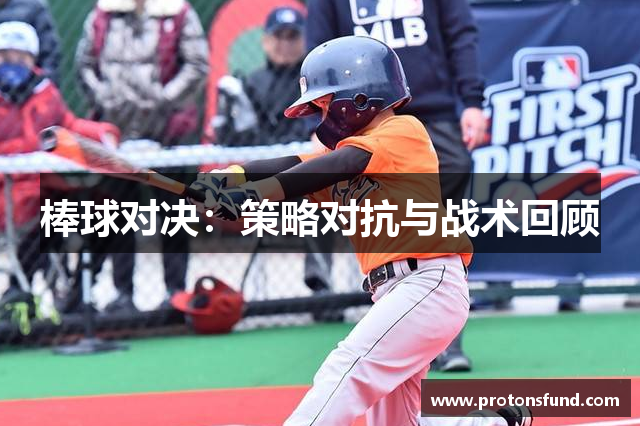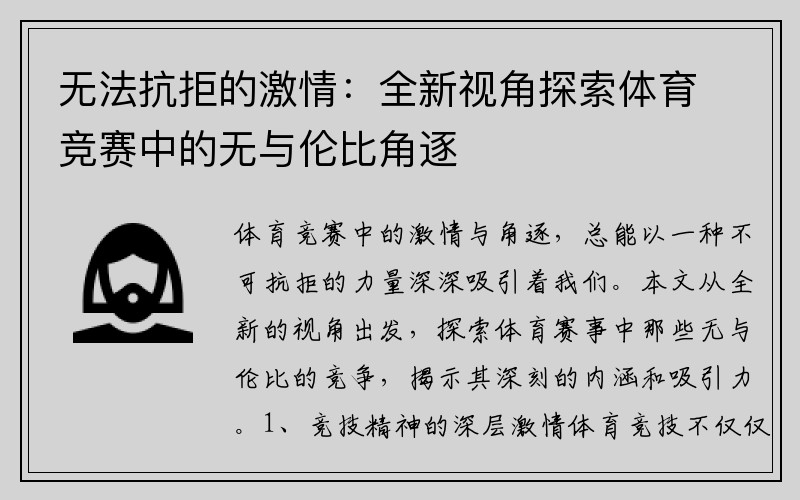棒球对决:策略对抗与战术回顾
Certainly! Here's the structured 3000-word article on "Baseball Duels: Strategy Confrontation and Tactical Review".
---
**Abstract:**
In the realm of baseball, matches are not merely athletic contests but intricate battles of strategy and tactics. This article delves into the nuanced art of strategic confrontations and tactical reviews in baseball. From the meticulous planning of game strategies to the agile deployment of tactics on the field, every aspect contributes to the dynamic interplay that defines the sport. Exploring the strategic decisions of coaches, the tactical maneuvers of players, the role of data analytics, and the historical evolution of strategies, this article offers a comprehensive view of how baseball's duels unfold beyond the surface level.
---
**1、Coaching Strategies**
Coaching in baseball involves more than just team management; it encompasses strategic planning that can determine the outcome of a game or even a season.
1、Strategic Planning and Preparation
Effective coaching begins long before players step onto the field. Coaches analyze opponents, study statistics, and devise game plans tailored to exploit weaknesses and leverage strengths. This phase involves detailed scouting reports and simulation of game scenarios to anticipate various outcomes.
Once strategies are formulated, coaches communicate them to players through drills and simulations. This ensures that each player understands their role within the overall strategy and is prepared to execute it under pressure.
Moreover, strategic planning extends beyond individual games to encompass long-term objectives such as season goals, roster management, and player development strategies.
2、In-Game Decision Making
During games, coaches must make split-second decisions that can shift momentum. This includes determining pitching changes, adjusting defensive alignments based on batter tendencies, and deciding when to employ strategic plays such as bunts, steals, or intentional walks.
These decisions are often influenced by real-time data analytics, which provide insights into pitcher-batter matchups, defensive efficiency, and situational probabilities.
Adaptability is key as coaches must continually reassess and adjust strategies based on unfolding game dynamics and opponent adjustments.
3、Strategies for Playoff and Championship Games
As the season progresses, coaching strategies intensify during playoff and championship series. Coaches may adopt more conservative or aggressive tactics depending on the stakes, opponent strengths, and team momentum.
Strategies often emphasize maximizing player performance under pressure, minimizing errors, and exploiting opponent vulnerabilities identified throughout the season.
Successful coaching in these critical games often hinges on maintaining team morale, managing player fatigue, and strategically utilizing bench players.
---
**2、Player Tactics**
Players in baseball are not just athletes; they are strategists on the field, constantly adjusting their tactics based on the game situation and opponent actions.
1、Offensive Tactics
Offensive players employ various tactics to outsmart opposing pitchers and defenders. This includes studying pitcher tendencies, pitch recognition, and adjusting batting techniques to exploit weaknesses in the defense.
Players often employ strategic plays such as hit-and-run, sacrifice bunt, and stealing bases to advance runners and pressure the defense.
The ability to execute these tactics effectively requires split-second decision-making, timing, and awareness of game situations.
2、Defensive Maneuvers
Defensive players utilize tactics to neutralize offensive threats and capitalize on opponent mistakes. This involves positioning adjustments based on batter tendencies, pitcher command, and situational awareness.
Players must anticipate plays, communicate effectively with teammates, and execute defensive strategies such as double plays, outfield assists, and pitch framing to gain a competitive advantage.
The effectiveness of defensive tactics often determines the outcome of close games and critical innings.
3、Pitching Strategies
Pitchers employ a variety of strategies and tactics to outwit batters and control the game tempo. This includes mixing pitches, changing speeds, and locating pitches in specific zones to exploit batter weaknesses.
Effective pitching strategies also involve understanding scouting reports, studying hitter tendencies, and adjusting game plans based on in-game developments.
The ability to maintain composure under pressure and execute pitches according to plan is crucial to pitching success.
---
**3、Role of Data Analytics**
九游会j9官方网站Data analytics has revolutionized baseball strategy, providing teams with insights that influence decisions both on and off the field.
1、Pre-game Preparation
Teams utilize advanced metrics and statistical analysis to inform strategic decisions before games. This includes evaluating opponent tendencies, player matchups, and situational probabilities to optimize lineup configurations and game strategies.
Data-driven insights also influence defensive alignments, pitching rotations, and bullpen usage based on historical performance data.
Analytics play a pivotal role in identifying trends, patterns, and inefficiencies that can be exploited to gain a competitive edge.
2、In-game Decision Support
During games, real-time analytics provide coaches with actionable insights to guide in-game decisions. This includes pitcher-batter matchup data, defensive positioning recommendations, and optimal timing for strategic plays.
Coaches and players use these insights to adjust tactics on the fly, capitalize on opponent weaknesses, and mitigate risks in high-leverage situations.
The integration of analytics enhances decision-making precision and empowers teams to make data-driven adjustments throughout the game.
3、Player Development and Performance Analysis
Beyond game strategy, analytics contribute to player development and performance evaluation. Teams analyze player metrics, biomechanics, and health data to optimize training programs, prevent injuries, and enhance overall performance.
Longitudinal data analysis helps identify player potential, refine scouting processes, and inform personnel decisions such as trades and acquisitions.
The continuous evolution of analytics continues to reshape how teams evaluate talent and strategize for future success.
---
**4、Historical Evolution of Strategies**
The strategies and tactics in baseball have evolved significantly over time, reflecting changes in rules, technology, and player capabilities.
1、Early Strategies and Innovations
Baseball's early strategies focused on fundamental skills such as hitting, fielding, and pitching. Strategies were rudimentary, relying on player instincts and limited statistical analysis.
Early innovations included the introduction of strategies such as the stolen base, defensive shifts, and strategic pitching changes.
Strategies were often influenced by individual player talents and managerial preferences rather than systematic analysis.
2、Modern Era Transformations
The advent of data analytics in the late 20th century transformed baseball strategy. Teams began using statistical analysis to optimize player performance, develop game strategies, and evaluate opponent weaknesses.
Strategies evolved to include more sophisticated tactics such as bullpen specialization, pitch framing, and launch angle optimization.
Managers increasingly relied on statistical probabilities and matchup data to make informed decisions during games.

3、Contemporary Trends and Innovations
In the contemporary era, strategies continue to evolve with advancements in technology and analytics. Teams employ predictive modeling, machine learning, and artificial intelligence to forecast player performance and strategize more effectively.
Strategies emphasize maximizing run production through advanced metrics such as on-base percentage, slugging percentage, and weighted runs created.
Defensive shifts, pitch sequencing, and bullpen management have become standard practices based on extensive data analysis.
---
**Conclusion:**
In conclusion, baseball's strategic confrontations and tactical reviews exemplify the sport's depth beyond athleticism. Coaches orchestrate meticulous game plans, players execute tactical maneuvers with precision, data analytics provide crucial insights, and historical evolution shapes the strategies of today. Together, these elements underscore baseball's status as a strategic battlefield where every decision, from the dugout to the diamond, influences outcomes. Understanding these dynamics enhances appreciation for the strategic complexity that defines baseball as both a sport and a mental contest.
Baseball's strategic evolution and tactical nuances highlight its complexity as both a sport and a mental contest.

